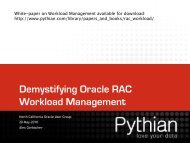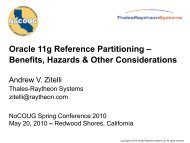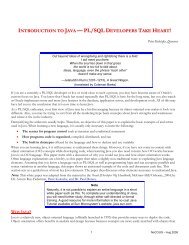Q&A with Juan Loaiza Stay Focused on the Five Steps ... - NoCOUG
Q&A with Juan Loaiza Stay Focused on the Five Steps ... - NoCOUG
Q&A with Juan Loaiza Stay Focused on the Five Steps ... - NoCOUG
You also want an ePaper? Increase the reach of your titles
YUMPU automatically turns print PDFs into web optimized ePapers that Google loves.
ing in failure. The lack of actual decisi<strong>on</strong>making ability makes<br />
<strong>the</strong> script model inadequate for automating complex tasks.<br />
At first glance, <strong>the</strong>se challenges appear insurmountable,<br />
<strong>the</strong>reby making true lightsout automati<strong>on</strong> a distant gleam in<br />
<strong>the</strong> eyes of most DBAs and IT managers. But <strong>the</strong>se are precisely<br />
areas where DA can come to <strong>the</strong> rescue.<br />
This is because even though database administrati<strong>on</strong> is<br />
complex, like o<strong>the</strong>r IT support areas, a large chunk can be<br />
automated provided such efforts are preceded by standard<br />
task plan definiti<strong>on</strong>s. DA can be leveraged to make such task<br />
plans more generic and reusable across a variety of envir<strong>on</strong>ments.<br />
Doing so will free up human database administrators<br />
to focus <strong>on</strong> higher value tasks, reduce human errors in mundane<br />
areas, and allow documented procedures to be c<strong>on</strong>sistently<br />
applied, resulting in uniform output.<br />
Case Study<br />
Let’s take an example to understand <strong>the</strong> use of DA in DBA<br />
automati<strong>on</strong>—adding data files to a database. Oracle has a<br />
datafile autoextend feature wherein <strong>the</strong> underlying files that<br />
make up <strong>the</strong> database can grow <str<strong>on</strong>g>with</str<strong>on</strong>g>out restricti<strong>on</strong> to accommodate<br />
transacti<strong>on</strong>s. However many IT organizati<strong>on</strong>s<br />
have hard limits <strong>on</strong> how big <strong>the</strong>ir datafiles can grow. These<br />
limits are placed for a variety of reas<strong>on</strong>s, but mostly <strong>the</strong>y are<br />
a part of IT requirements to facilitate backups to occur in <strong>the</strong><br />
most effective manner and adhere to file system quotas established<br />
by systems<br />
We tend to equate<br />
automati<strong>on</strong> <str<strong>on</strong>g>with</str<strong>on</strong>g><br />
“scripts” . . . ifelse<br />
logic amounts to<br />
evaluating a<br />
sequence of alreadymade<br />
decisi<strong>on</strong>s.<br />
The <strong>NoCOUG</strong> Journal<br />
adminstrators. Once<br />
<strong>the</strong>se limits are enabled,<br />
when <strong>the</strong> file<br />
a u toextends a n d<br />
reaches that size, that<br />
part of <strong>the</strong> database<br />
(called a tablespace)<br />
fails to grow any fur<strong>the</strong>r<br />
until a DBA adds<br />
ano<strong>the</strong>r datafile to<br />
that tablespace—ei<br />
<strong>the</strong>r manually up<strong>on</strong> receiving a spacebound alert or automatically<br />
via a script that is triggered in resp<strong>on</strong>se to that alert.<br />
A typical script will check <strong>the</strong> mountpoint(s) of <strong>the</strong> existing<br />
datafile(s) and o<strong>the</strong>r preapproved mountpoints. If no<br />
free space is found in <strong>the</strong>se locati<strong>on</strong>s, <strong>the</strong> script will exit <str<strong>on</strong>g>with</str<strong>on</strong>g><br />
an error message. By leveraging DA, such inefficiencies can be<br />
a thing of <strong>the</strong> past. DA can bring about a layer of thinking and<br />
acti<strong>on</strong> based <strong>on</strong> available metadata and prior acti<strong>on</strong>s. With<br />
regard to our example, if no free space is found in <strong>the</strong> preapproved<br />
mountpoints, DA can trigger a discovery process to<br />
look for any newly allocated mountpoints outside <strong>the</strong> preapproved<br />
range; ensure <strong>the</strong>y are usable (i.e., <strong>the</strong>y are not NFS<br />
mounted, etc.); and in some cases, if n<strong>on</strong>e are found, provisi<strong>on</strong><br />
additi<strong>on</strong>al space <strong>on</strong> <strong>the</strong> disk subsystem in real time and<br />
add <strong>the</strong> file in <strong>the</strong> best possible place. If provisi<strong>on</strong>ing <strong>the</strong> space<br />
requires special privileges, it can send out an email or ticket<br />
to <strong>the</strong> sys admin group, sleep in <strong>the</strong> background, check periodically<br />
for <strong>the</strong> space being available, and when it is finally<br />
available, add <strong>the</strong> file.<br />
Via DA, <strong>the</strong> script can also decide that since it is adding <strong>the</strong><br />
file in an unauthorized mountpoint (i.e., a new mountpoint<br />
that’s not <strong>on</strong> <strong>the</strong> list of preapproved names supplied to <strong>the</strong><br />
script at run time), it can check <strong>the</strong> freespace threshold and if<br />
it is “significantly past <strong>the</strong> warning level,” create a smaller than<br />
usual file to accommodate current growth in data and <strong>the</strong>n<br />
email <strong>the</strong> DBA or sys admin about this event. They can <strong>the</strong>n<br />
provisi<strong>on</strong> and add appropriate mountpoints and <strong>the</strong>n move<br />
<strong>the</strong> newly added file to <strong>the</strong> o<strong>the</strong>r mountpoint. Thus, any applicati<strong>on</strong><br />
outages are averted by making space available in <strong>the</strong><br />
short term as <strong>the</strong> database needs to grow and <strong>the</strong>n giving <strong>the</strong><br />
DBA/sys admins <strong>the</strong> buffer to clean up later.<br />
The above paragraph references <strong>the</strong> words “significantly<br />
past <strong>the</strong> warning level.” Fuzzy logic can be used to interpret<br />
available space and see if does meet <strong>the</strong> requirements for<br />
being classified as “significantly past <strong>the</strong> warning level.” If say,<br />
90% is <strong>the</strong> warning level and 99% is <strong>the</strong> critical level, how<br />
should 98.5% be classified? And how should 91% be classified<br />
when <strong>the</strong> current data volume growth rate is 300% higher<br />
than “normal?” A threshold check via traditi<strong>on</strong>al scripting<br />
tools would not trigger <strong>the</strong> “significantly past” threshold in<br />
<strong>the</strong> former case since it’s 0.5% below <strong>the</strong> critical level. Also,<br />
traditi<strong>on</strong>al scripting tools wouldn’t be able to accommodate<br />
external variables such as data growth rate in <strong>the</strong>ir decisi<strong>on</strong><br />
making because <strong>the</strong> values are not readily accessible and are<br />
too timec<strong>on</strong>suming to compute <strong>on</strong> <strong>the</strong> fly.<br />
As such, for DA to be truly valuable and allow lightsout<br />
automati<strong>on</strong>, <strong>the</strong>re’s a need for <strong>the</strong> DA algorithms to be able<br />
to simulate rati<strong>on</strong>al human behavior when c<strong>on</strong>fr<strong>on</strong>ted <str<strong>on</strong>g>with</str<strong>on</strong>g><br />
<strong>the</strong> simplest of problems (it doesn’t get any simpler than adding<br />
space to a database) by being able to think, decide, and act<br />
ra<strong>the</strong>r than merely evaluating available choices. It needs to<br />
be able to build a new choice list and determine appropriate<br />
behavior related to each choice. 1<br />
The DA-Based Approach<br />
The above need can be satisfied by leveraging an expert<br />
system. This system would handle <strong>the</strong> thinking porti<strong>on</strong> and<br />
rely <strong>on</strong> a library of automated routines corresp<strong>on</strong>ding to task<br />
plans, to implement <strong>the</strong> most appropriate acti<strong>on</strong>—all based<br />
<strong>on</strong> <strong>the</strong> opti<strong>on</strong>s available to make a decisi<strong>on</strong>. Each decisi<strong>on</strong><br />
opti<strong>on</strong> is ranked based <strong>on</strong> how well it would satisfy <strong>the</strong> business<br />
requirement and accordingly, <strong>the</strong> <strong>on</strong>e <str<strong>on</strong>g>with</str<strong>on</strong>g> <strong>the</strong> highest<br />
rank is implemented.<br />
For <strong>the</strong> expert system to use DA techniques, it needs to<br />
know what <strong>the</strong> different variables are that need to be c<strong>on</strong>sidered<br />
when making a decisi<strong>on</strong>. For instance, in <strong>the</strong> case of<br />
adding space, <strong>the</strong> primary variables are available disk space,<br />
required disk space, urgency level, and competitiveness of <strong>the</strong><br />
objects in <strong>the</strong> tablespace. Each of <strong>the</strong>se primary variables<br />
is usually dependent <strong>on</strong> several sec<strong>on</strong>dary variables. For instance,<br />
required disk space is a functi<strong>on</strong> of how much data is<br />
being added to that tablespace, how quickly it’s growing compared<br />
to historical metrics, and whe<strong>the</strong>r this current growth<br />
is a temporary spike that will end before <strong>the</strong> tablespace completely<br />
runs out of space. These variables are often interdependent;<br />
for instance, <strong>the</strong> current growth curve could feed<br />
(c<strong>on</strong>tinued <strong>on</strong> page 19)<br />
1 Editorial comment: Examples include moving objects, compacting<br />
objects, deleting objects (e.g., unused indexes), and changing <strong>the</strong><br />
growth characteristics of objects.








